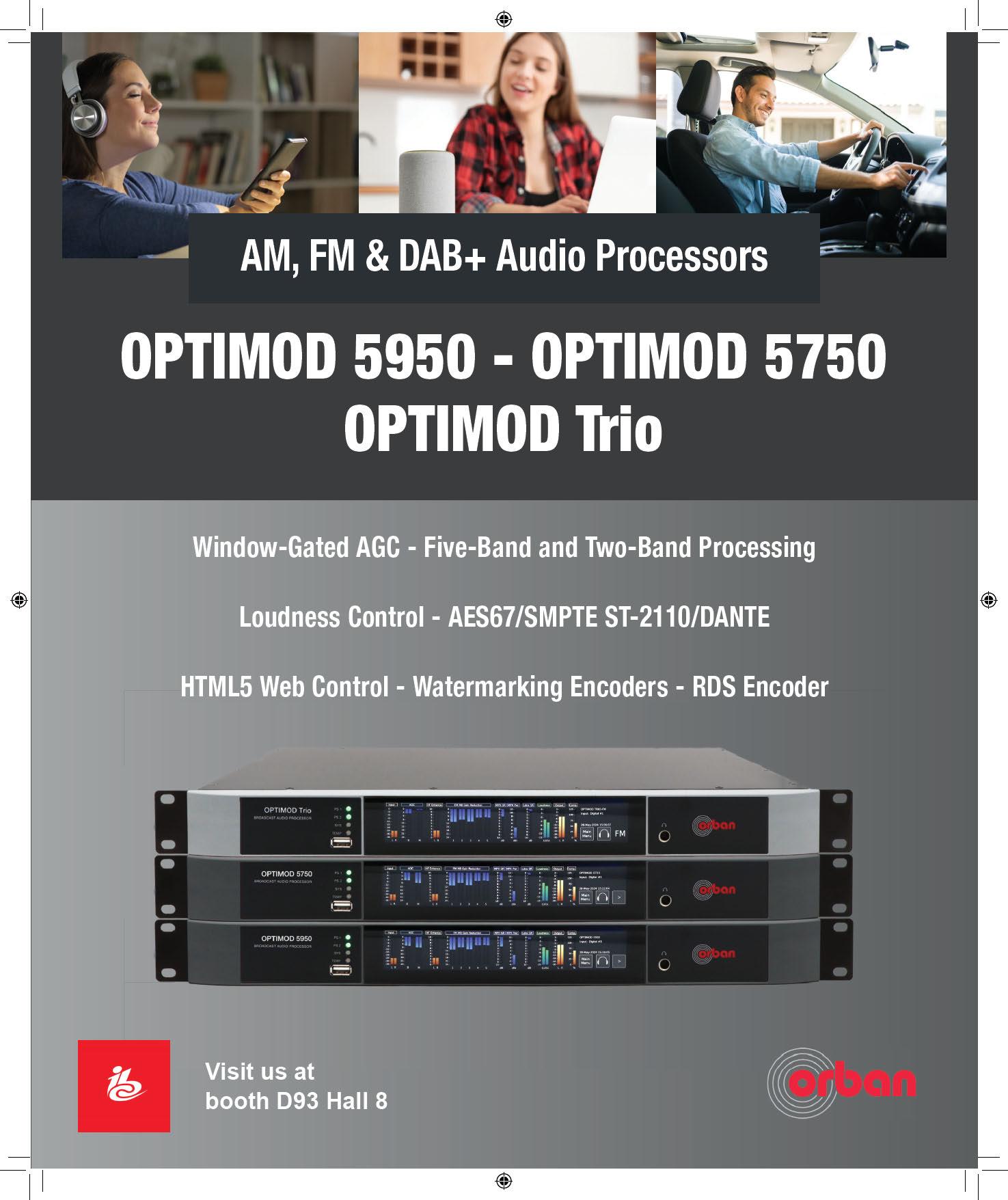Welcome to the September 11th,





















Welcome to the September 11th,




















NAB and AES gather once again; here’s what’s on the agenda for radio, podcasting and audio folks












Vol. 48 No. 19 | September 11 2024
www.radioworld.com
FOLLOW US
www.twitter.com/radioworld_news
www.facebook.com/RadioWorldMagazine www.linkedin.com/company/radio-world-futureplc
CONTENT
Managing Director, Content & Editor in Chief Paul J. McLane, paul.mclane@futurenet.com, 845-414-6105
Assistant Editor & SmartBrief Editor Elle Kehres, elle.kehres@futurenet.com
Technical Advisors W.C. “Cris” Alexander, Thomas R. McGinley, Doug Irwin
Contributors: David Bialik, John Bisset, Edwin Bukont, James Careless, Ken Deutsch, Mark Durenberger, Charles Fitch, Donna Halper, Alan Jurison, Paul Kaminski, John Kean, Nick Langan, Larry Langford, Mark Lapidus, Michael LeClair, Frank McCoy, Jim Peck, Mark Persons, Stephen M. Poole, James O’Neal, T. Carter Ross, John Schneider, Gregg Skall, Dan Slentz, Dennis Sloatman, Randy Stine, Tom Vernon, Jennifer Waits, Steve Walker, Chris Wygal
Production Manager Nicole Schilling
Senior Design Director Lisa McIntosh
Senior Art Editor Will Shum
ADVERTISING SALES
Senior Business Director & Publisher, Radio World John Casey, john.casey@futurenet.com, 845-678-3839
Publisher, Radio World International Raffaella Calabrese, raffaella.calabrese@futurenet.com, +39-320-891-1938
SUBSCRIBER CUSTOMER SERVICE
To subscribe, change your address, or check on your current account status, go to www.radioworld.com and click on Subscribe, email futureplc@computerfulfillment.com, call 888-266-5828, or write P.O. Box 1051, Lowell, MA 01853.
LICENSING/REPRINTS/PERMISSIONS
Radio World is available for licensing. Contact the Licensing team to discuss partnership opportunities. Head of Print Licensing Rachel Shaw licensing@futurenet.com
MANAGEMENT
SVP, MD, B2B Amanda Darman-Allen
VP, Global Head of Content, B2B Carmel King MD, Content, Broadcast Tech Paul J. McLane
VP, Head of US Sales, B2B Tom Sikes
Managing VP of Sales, B2B Tech Adam Goldstein VP, Global Head of Strategy & Ops, B2B Allison Markert VP, Product & Marketing, B2B Andrew Buchholz Head of Production US & UK Mark Constance Head of Design, B2B Nicole Cobban FUTURE US, INC.
Future US LLC, 130 West 42nd Street, 7th Floor, New York, NY 10036

All contents ©Future US, Inc. or published under licence. All rights reserved. No part of this magazine may be used, stored, transmitted or reproduced in any way without the prior written permission of the publisher. Future Publishing Limited (company number 02008885) is registered in England and Wales. Registered office: Quay House, The Ambury, Bath BA1 1UA. All information contained in this publication is for information only and is, as far as we are aware, correct at the time of going to press. Future cannot accept any responsibility for errors or inaccuracies in such information. You are advised to contact manufacturers and retailers directly with regard to the price of products/services referred to in this publication. Apps and websites mentioned in this publication are not under our control. We are not responsible for their contents or any other changes or updates to them. This magazine is fully independent and not affiliated in any way with the companies mentioned herein.
If you submit material to us, you warrant that you own the material and/ or have the necessary rights/permissions to supply the material and you automatically grant Future and its licensees a licence to publish your submission in whole or in part in any/all issues and/or editions of publications, in any format published worldwide and on associated websites, social media channels and associated products. Any material you submit is sent at your own risk and, although every care is taken, neither Future n or its employees, agents, subcontractors or licensees shall be liable for loss or damage. We assume all unsolicited material is for publication unless otherwise stated, and reserve the right to edit, amend, adapt all submissions.
Radio World (ISSN: 0274-8541) is published bi-weekly by Future US, Inc., 130 West 42nd Street, 7th Floor, New York, NY 10036. Phone: (978) 667-0352. Periodicals postage rates are paid at New York, NY and additional mailing offices. POSTMASTER: Send address changes to Radio World, PO Box 1051, Lowell, MA 01853.
Please recycle. We are committed to only using magazine paper which is derived from responsibly managed, certified forestry and chlorine-free manufacture. The paper in this magazine was sourced and produced from sustainable managed forests, conforming to strict environmental and socioeconomic standards. The manufacturing paper mill and printer hold full FSC and PEFC certification and accreditation.

Paul McLane Editor in Chief
In July the engineering team at Cumulus Media station WJR(AM) in Detroit hosted members of the emergency alerting community from around southeast Michigan for a tour of its transmitter site.
I spotted the group photo in the newsletter of the Michigan Association of Broadcasters and thought it seemed an excellent example of how broadcasters can interact with local authorities.
In recent years the Federal Emergency Management Agency has been conducting a program to harden Emergency Alert System infrastructure at several dozen of the country’s 77 Primary Entry Point stations in the National Public Warning System.
These PEP stations, as most RW readers know, work with FEMA to provide emergency alert and warning information to the public before, during and after incidents and disasters. They’re also a primary source of initial broadcast for a national alert. They need to withstand natural disasters and man-made events to ensure continuity of operations.
The “all-hazards” FEMA upgrades include increased sheltering capabilities, expanded broadcast capacity and sustainable power generation for all types of hazardous events. Studios in standalone modules ensure that PEP radio stations are capable of broadcasting during and after emergencies when other communication sources may be down.
WJR is the PEP station for Michigan and in 2018 it was the first in the country to receive the upgrade.
Dan Kelley, MAB’s director of technical services and co-chair of Michigan’s State Emergency Communications Committee, told me that he and Jaclyn Barcroft of the Michigan State Police Emergency Management and Homeland Security Division met a while back with Manny Centeno. As the program manager for the FEMA’s Integrated Public Alert & Warning System, he was responsible for coordinating these upgrades. (Centeno recently was promoted to IPAWS director.)
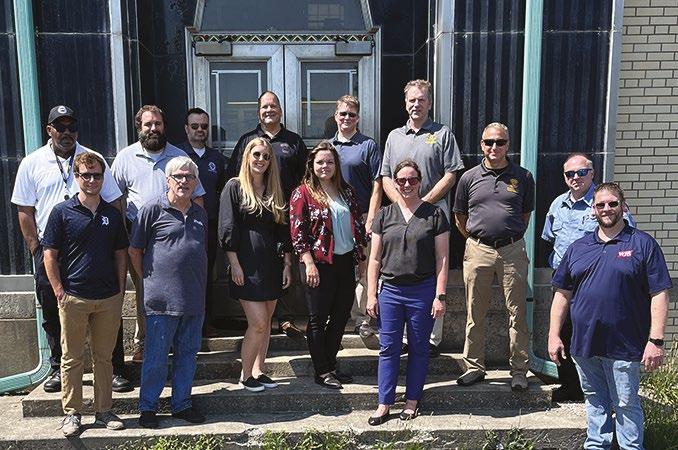

Manny suggested offering a tour of WJR at some point to raise awareness about the facility. So Dan and Jaclyn Barcroft reached out to Keith Bosworth, Cumulus regional director of engineering for the Great Lakes Region, to schedule a visit and lunch.
The tour attracted representatives from the Michigan State Police Emergency Management and Homeland
Security Division, Michigan Association of Broadcasters, City of Dearborn Emergency Management Division, City of Detroit Homeland Security and Emergency Management, Canton Township Emergency Management Division, City of Livonia Office of Emergency Preparedness, Macomb County Emergency Management and Port Huron-based radio station WPHM(AM). Many of the people who attended are responsible for issuing emergency alerts to the public during an emergency or disaster.
Dan told me that most broadcasters and alerting authorities in Michigan stand behind the same mission of working together to provide lifesaving information to the public quickly during emergencies and disasters. The state EAS plan was approved by the FCC in late 2022, and the Southeastern Michigan EAS region recently met to start working together to update their own area EAS plan.
Dan added that the station visit impressed him. For one thing, he said, WJR has no fewer than three 50 kW transmitters that can go on the air at any time, another 10 kW as a backup, and inside the FEMA shelter on site is another 5 kW transmitter. Let’s hear it for redundancy.
(You can see striking images of the main Art Deco transmitter building by Googling “WJR transmitter building” and then clicking “Images.” Got an idea for how to work better with your local alerting authorities? Email me at radioworld@futurenet.com.)

Writer

Randy
J. Stine
NAB and SBE stepped in to fill a gap left earlier by the FCC
No one wants to run afoul of the FCC during an inspection. The Society of Broadcast Engineers and the National Association of Broadcasters are offering members a new way to help protect their licenses and assets.
They released a self-inspection guideline for FM radio stations this spring. It is available to SBE and NAB members via download from the organizations’ websites. There is also a TV version; and guides for AMs, LPFMs, translators/boosters and distributed television services are planned.
The FCC stopped publishing self-inspection checklists in 2003, but rules and policies have continued to change since then. These guides are designed to help stations as well as contract inspectors in the Alternative Broadcast Inspection Program in evaluating a station’s compliance with FCC rules and regulations. In some states, stations that participate in the ABIP can receive a three-year exemption from routine FCC inspections.
Rules violations can lead to delays in the FCC’s processing of an application, penalties including substantial monetary forfeiture, a shorter license authorization or even loss of a station’s license, according to the document.
Ched Keiler, chair of the SBE committee that created the guides, said the documents provide an up-todate, standardized guidance to help broadcasters comply. Sections of the 71-page SBE FM Broadcast Station Self-Inspection Guide cover a variety of topics, from authorizations and programming related rules to EAS, public inspection file and an array of technical

“SBE has long been known for its role in education of broadcast engineers. It made a lot of sense to take on a project of this magnitude. ”
“Recommended Practice” notes in a series of callout boxes. SBE and NAB emphasize that these guides have not been approved or endorsed by the commission. They don’t cover every regulation, nor are they intended as legal advice or opinions. But they reflect a great deal of work and expertise. Stations can use them to assess compliance with regulations most likely to pose an enforcement risk.
Ched Keiler spoke with us about the initiative.
What is involved in putting together an ambitious document like this?
Ched Keiler: The industry has long recognized that there was a need to replace the original FCC Check List documents.
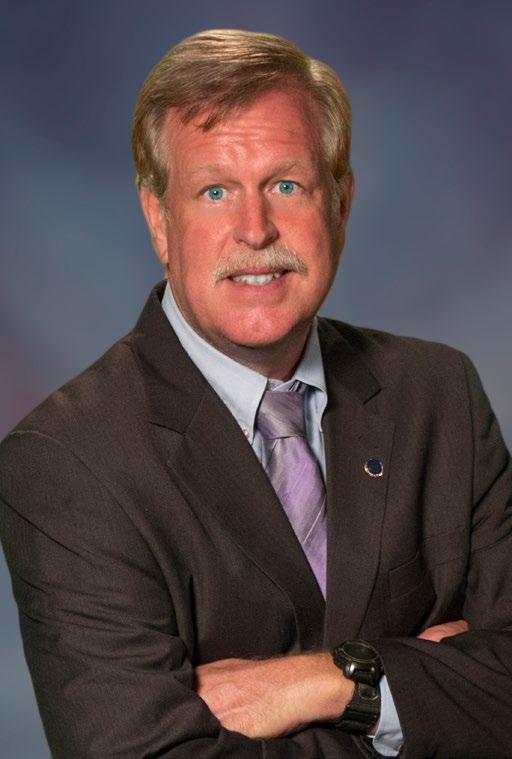
They fulfilled their role back in the 1990s and early 2000s but simply grew out of date as the industry moved on.
The Society of Broadcast Engineers had been discussing the deficiencies of these documents for some time. SBE has long been known for its role in education of broadcast engineers. It made a lot of sense to take on a project of this magnitude.
The SBE Board of Directors decided in April 2022 to proceed with this project. They placed the project under its Government Relations Committee, which I chair. We knew this was going to be an ambitious project so I selected members for a newly formed subcommittee and we worked diligently to bring this project into fruition. There were many man hours spent on the project, along with significant monetary cost to SBE. I want to thank all those who partnered to bring this project to where it is today.
The guides are meant to be used by anyone who wants to help bring their facilities into compliance.
Whose input did you rely upon?
Keiler: I relied heavily on the committee that I mentioned. We met frequently to hammer out what the guides should say. I also formed a relationship with NAB, which reviewed and supplied comments to the documents. We also relied upon third parties for review and comments.
How did you decide what topics to include?
Keiler: We initially followed what was outlined in the prior FCC Check List documents. We did add and delete material as appropriate. We also came up with the concept of Recommended Practice or RP, which is basically a recommendation that a station should follow but is not required to. We decided not to label these “Best Practices” because there are so many variables that may or may not apply in an individual situation or station.
If a radio engineer were transported from the year 2003 to today and picked up this guide, what would they notice that’s different from back then?
and the FCC rules and regulations regarding proper operation and compliance.
Are there one or two sections you feel will be the most useful?
Keiler: There are many that can be beneficial to the broadcast engineer. One instance that comes to mind concerns FM modulation. I can remember the days of “loudness wars” with FM modulation in which one station competed with another to overmodulate in order to sound louder to the listener.
I came across this situation recently. One of my major-market clients wondered why the signals in his market sounded so poor. It turns out the stations were competing to be the loudest in the market, and thus grossly overmodulationg.
“The committee had numerous conversations about the granular scope of each section to assure that we did not create new rules. ”
We cover this issue in the SBE FM Guide. If the stations in that market had followed the FCC regulations and the SBE FM Guide’s Recommended Practice, this situation would not have occurred.
Were there any particularly difficult aspects of the process?
Keiler: I was very concerned that we were not creating new rules that didn’t exist within the FCC rules and regulations while maintaining the thoroughness and integrity of the guides. The committee had numerous conversations about the granular scope of each section to assure that we did not create new rules.
Do you have two or three tips that you wish more stations would follow?





Keiler: I think a radio engineer would see considerable changes that have occurred in the rules over time. For example, digital HD Radio or IBOC was in its infancy and many of the FCC rules that govern that service were not in place with the earlier FCC ABIP guides.

The SBE FM Guide was created to assist in providing guidance on how to comply with both the IBOC standard
Keiler: I would recommend that readers of the guides strongly adhere to the areas of the guides that speak about FCC compliance. I also think that readers should consider the Recommended Practices and try to deploy them to the best of their ability within their operations.
Turn the page to take our sample self-inspection quiz!



The new SBE FM Guide is a rich resource. Test your knowledge against these six sample questions, which we’ve based on information provided in the guide:
Q1: You’ve discovered that a member of the station staff broadcast EAS tones inappropriately as a special effect in a radio spot. The FCC requires that you notify it. Do you know the email address to use?
Q2: Many FM stations use Broadcast Auxiliary Services in the form of studiotransmitter links, intercity relays, remote pickup units and transmitter-studio links. Most such licenses are automatically renewed with the main station license. What should the station do if the BAS facility has been discontinued or the station moves its STL facilities?
Q3: Before recording an outgoing phone conversation for broadcast, the licensee must tell the other party of its intention to broadcast the conversation, unless the other party may be presumed to be aware. In what circumstances can the station make that presumption?
Q4: Regarding your station’s Public Inspection File, the FCC should automatically upload the authorizations, filed applications, filed ownership reports, filed EEO documents, contour maps and “The Public and Broadcasting Manual.” But it is the licensee’s responsibility to make sure these items are in place. What should you do if they are not?
Q5: Fill in the blank: Generally, antenna structures that are higher than ______ above ground level or that may interfere with the flight path of a nearby airport or could represent an obstruction to an aircraft must be studied by the Federal Aviation Administration and registered with the FCC.
Q6: Which types of FM stations are exempt from the requirement to have installed operational equipment capable of transmitting the EAS protocol?
Answers:
A1: Should any inappropriate use of EAS tones occur, the FCC requires that it be notified by email to FCCOPS@fcc.gov within 24 hours of discovery. (See page 19 of the guide.)
A2: BAS licenses that are no longer in use but still authorized and reflected in the FCC’s ULS database should be cancelled. This requires action by the station. Also, many stations move studios and their associated STL facilities while neglecting to modify the associated BAS licenses. Such moved facilities are considered unauthorized and require new or modified licenses; they also can create frequency coordination conflicts. (See page 12 of the guide.)
A3: Such awareness is presumed to exist only when the other party to the call is associated with the station (e.g. an employee or parttime reporter), or where the other party originates the call and it is obvious that it is in connection with a program in which the station customarily broadcasts phone conversations. (Page 16.)
A4: The authors of the Guide suggest that the licensee contact the PIF Help Desk for assistance, and consider manually uploading the missing docs to the appropriate Additional Documents folder. Periodic confirmation that all documents can be retrieved from the publicfacing (not the admin page) PIF is recommended. The public-facing PIF must be accessible from a link on the station’s home page. (Page 21.)
A5: 60.96 meters or 200 feet. (Page 31)
A6: Class D FM, low-power FM, FM booster and FM translator stations are the exceptions to the encoding equipment requirement, while the decoding requirement applies to all FM stations except boosters and translators. (Page 39.) But the fact that EAS encoding is optional in certain broadcast services does not relieve those stations from other EAS requirements; please see the appropriate guide for the relevant service.

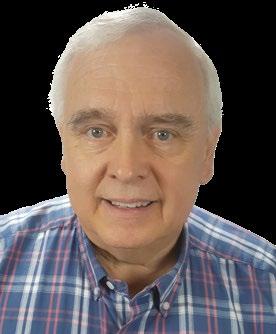
John Bisset
CPBE
The author is in his 34th year of writing Workbench. He handles western U.S. radio sales for the Telos Alliance and is a past recipient of the SBE’s Educator of the Year Award.
Doug Amacker has this advice: “Put it in a bucket!”
Agreat wind is blowing, and that gives you either imagination or a headache.” Catherine the Great is quoted as saying so. Perhaps she’d set up a remote broadcast or two in her time.
Send your tips Workbench submissions are encouraged and qualify for SBE recertification credit. Email johnpbisset@ gmail.com.
Doug Amacker is vice president and general manager of the Oxford Media Group including WBZK(FM) in Oxford, Miss. Wind brought him headaches during remote broadcasts because the feet of his pop-up tent could not be secured to asphalt or concrete. So Doug came up with the idea pictured here.
Buy yourself some empty paint cans and a bag of Quikrete or similar brand concrete mix at Lowes or Home Depot.
Your tent legs probably have holes in each flat metal foot, as seen in the second photo, but if not you can create them with your trusty drill.
Top WBZK GM Doug Amacker and his concrete bucket.
Below Doug attaches the footer of each tent leg into one of his customized buckets.
Then select four bolts to match the holes in the mounting feet. The bolts should be 4 to 5 inches long. Cover the last inch of the threads with electrical tape or with Vaseline or other petroleum jelly, to prevent the concrete from getting into the “business end” threads of the bolt. Fill each paint can with your Quikrete and sink the bolt, threads up, into the concrete. Make sure the bolt is centered and vertical, and that only an inch or so protrudes from the concrete. If you like, you can thread several nuts and fender washers along the length of the bolt to expand the anchor’s surface area set in the concrete.
Set the buckets aside and let the mixture harden for at least a week.
Then for your next remote, after you’ve set up your tent, you can lift




each leg onto the bolt-in-the-bucket. Use a wingnut and a fender washer to secure the leg to its new stand. Then let those winds blow!
They got the angle “right” What’s more satisfying than a tidy wiring installation? It’s in our DNA as radio engineers.
Frequent contributor Dan Slentz found that ShowMeCables.com has released a variety of right-angle RJ-45 patch cables. These are shielded Cat-6A and come in your choice of seven colors.
Patch cord lengths are from 12 inches up to 20 feet. Dan notes that these could come in handy in a data center or a radio studio that
uses today’s popular AoIP systems using RJ-45 cabling for their wiring. They can be ordered directly from the website.
cutbacks are good
There was a time when a broadcast engineer had only one or two stations for which to be responsible. Multiply that by 10 or more, and maybe you aren’t able to visit your sites regularly. So it’s not surprising that many of us may discover undergrowth like we see in the last photo, which we originally shared last month. Watch out for situations like this, given all the rain we’ve had in much of the U.S. (The tower also needs a fresh coat of paint.)

The
Right ShowMeCables.com offers right-angled RJ-45 patch cables.
Below
Keep vegetation under control by visiting sites at least monthly.





Writer Paul McLane
Editor in Chief
Here’s what’s on the agenda for radio, podcasting and audio folks
October brings the return of the NAB Show New York conference and the separate but collocated AES Show New York at the Javits Convention Center in the Big Apple.
How to Go
Where: Jacob Javits Convention Center, New York City
When: Oct. 8–10, 2024
How: nabshow.com/ newyork2024 and aesshow.com
The NAB show this year will emphasize “Culture, Creativity and Commerce.”
The event last year drew about 12,300 people, almost a quarter of whom had technical job titles, according to the show website.
Many of the techie folks are drawn by an exhibit floor that also provides access to AES Show booths via connecting hallways (see a list of sample exhibitors on page 20).
Radio-related content includes a forum about radio and podcasting issues; the Marconi Radio Awards; and presentation of the National Radio Award to David Santrella.
NAB: Forum
The “Radio + Podcast Interactive Forum” takes place on Wednesday Oct. 9 from 10 a.m. to 3:10 p.m.

“Innovators in radio, podcast, tech and marketing share winning strategies to leverage technology for content and profit.” These sessions will include roundtables at which attendees can share ideas and network.
“It Takes a Team: How Talent Works Across the Team to Create Winning Shows” — Podcast and radio talents discuss how to create successful shows and promotions. Guests include Patty Jackson, host on iHeartMedia station WDAS(FM) in Philadelphia; Sarah Jenness, executive producer of The Moth podcast; and Harlen Lobley, director of sales and sports director for AlphaMedia East Texas. Consultant Mike McVay moderates.
“How Marketing and Technology Work Together to Grow and Engage Audiences” — This session promises to provide perspectives from marketing and technology experts about promotions and monetization strategies and how technology can support those efforts. Speaking are Jason Hoch, CEO and chief creative officer of Wavland, and Alex Roman, CTO at MediaCo New York. The moderator is Julie Koehn, president of Lenawee Broadcasting.
“The New Playbook: Producing Innovative Sports and News Content” — A panel of news and sports radio programmers, podcasters and tech professionals talk about fresh approaches including the role of AI. They include Sarah Foss, CTO of Audacy; Mary Menna, regional VP and market manager for Beasley Media Group Boston; and Jonathan Williamson, executive producer and head of production at Men in Blazers, a soccer media network.
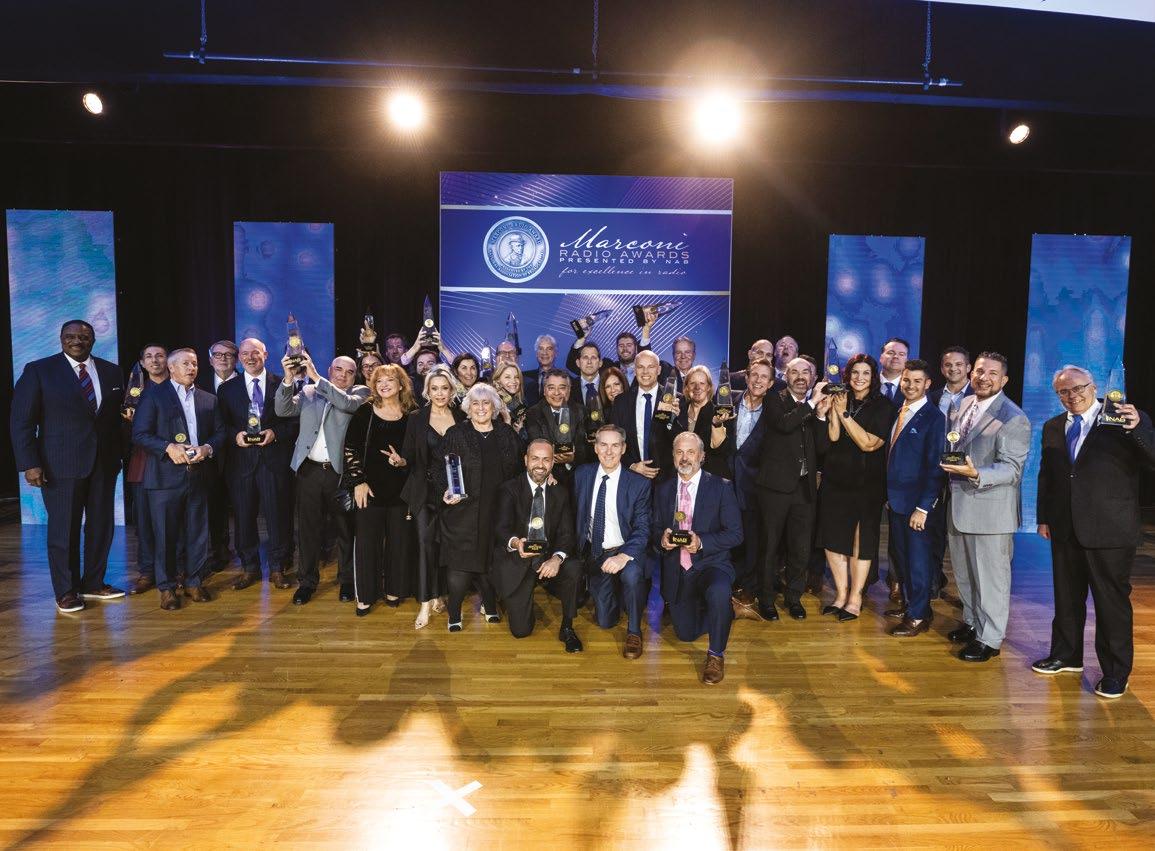
“Innovative Sound Design and Video Strategies for Radio and Podcasts” — Matt DeGroot is VP of production for Crooked Media/Pod Save America. Yervant Keshishian is sales engineer, trainer and technical director of Varto Technologies. Dan Hirschl is VP of engineering for Red Apple Media and chief engineer of WABC. John Clark is senior vice president of emerging technology and executive director of NAB PILOT.
“Leveraging Data Insights to Improve Programming, Promotions and Bottom Lines” — Panelists explore how radio and podcast programmers and producers use data to hone in on audiences and understand where the opportunities are. Dan Bobkoff, CEO of Rhyme Media; Laura Ivey, director of research at Edison Research; Sam Milkman, executive VP of Coleman Insights; and Colby Tyner, senior VP of programming for Radio One and Reach Media. Consultant Andy Meadows is moderator.
David Santrella will be honored with the 2024 National Radio Award.
The NAB said he has been a pivotal figure in the radio industry for nearly 40 years.
“Since becoming CEO of Salem Media Group in January 2022, he has led the company through significant growth, particularly in its digital platforms. Under his leadership, Salem has launched the successful Salem Surround, Salem Podcast Network, SalemNOW and Salem News Channel, establishing the company as a leader across 30 markets.”


He chaired the NAB Joint Board of Directors from June 2021 to June 2023 and has served on the board of the NAB Leadership Foundation.
“Santrella’s career began in Chicago, where he worked with NBC’s WMAQ and CBS’s WBBM before joining Salem in 2001,” NAB said.
“He quickly ascended through the ranks, taking on roles of increasing responsibility, including operations vice president, president of Salem’s Radio division, and eventually president of Broadcast Media.”
NAB President/CEO Curtis LeGeyt called him “a leader whose belief in radio’s unique ability to serve the public is second to none” and highlighted Santrella’s “public service ethos, along with a keen business acumen and authentic leadership style.”
The evening of Oct. 9 will bring the 2024 NAB Marconi Radio Awards, given at a dinner event that also will be livestreamed. The awards recognize radio stations and on-air personalities for excellence.
A big category each year is Network/Syndicated Personality of the Year. In 2024 Reach Media/Urban One has three of the five finalists. They are Erica Campbell, D.L. Hughley and Rickey Smiley. Also making the finalist cut are Dan Patrick of Premiere Radio Networks and Enrique Santos of iHeartMedia.
Another notable category is Legendary Station Manager of the Year. Finalists for that include Julie Koehn of Lenawee Broadcasting, Joe Bell of Beasley Media Group, Nick Martin of Big River Broadcasting Corp., Timoty P. Davies of Urban One and Bennett Zier of Audacy.
And with an eye on November, the show will feature an Election Coverage Summit.
“Key topics will include improving trust in political coverage with a deep dive into RTDNA’s research and


best practices to address skepticism about media bias,” organizers said on the website.
“The summit will also tackle ensuring verified news in the age of AI and social media, discussing how stations are combating misinformation and the rise of deep fakes. Also important is how journalists prepare their audience for the aftermath of the election and stay safe while covering political events.”
While all that is going on, the Audio Engineering Society will be holding its annual flagship event for audio professionals, enthusiasts and exhibitors next door within the Javits Center.
The society expects around 10,000 people to attend and promises workshops, panels, demos and training sessions.
Program details were limited as this issue of Radio World was being prepared but the list of session headlines provides insight into the range of topics.
The session “NPR’s Tiny Desk” will provide a look at the history of that popular program and where it’s headed next. Another will explore the evolution of live radio remotes.
A presentation called “BBC Pop Hub” will describe the move of Europe’s largest radio station. Another will dive into generative AI and machine learning workflows in audio.
A “town hall” will explore issues around diversity, equity and inclusion. Other topics on the AES agenda include adventures in live streaming, audio design, the state of the music business, sustainability in music technology manufacturing and the technical legacy of Robert Moog.

Exhibit Hall Hours
Tuesday, Oct. 8
(AES only):
1 p.m.–6 p.m.
Wednesday, Oct. 9: 10 a. m.–6 p.m.
Thursday, Oct. 10:
10 a.m.–5 p.m.
The following is a sampling of exhibits of interest to radio. See show websites for a full list. NAB New York and AES New York are collocated, with a shared exhibition floor providing access to both shows via a common hallway.
Adder Technology NAB 1107
AEA Ribbon Mics AES 535
Amazon Web Services NAB 929
ATC Labs NAB 759
Audinate NAB 646
Audio History Library & Museum AES 445
Audio-Technica AES 447
AxelTech NAB 1414
BIS – Broadcast Integration Services NAB 1104
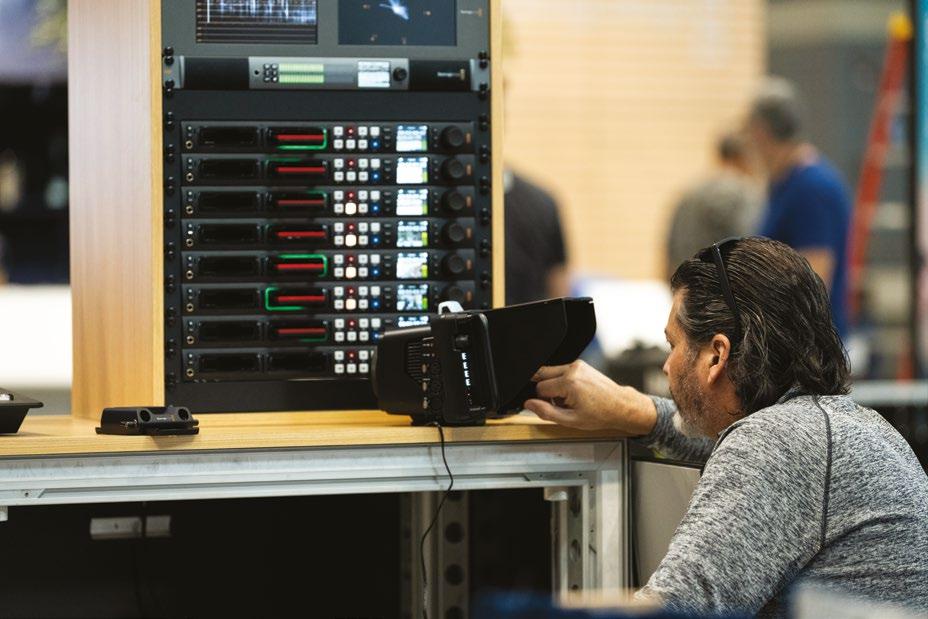











Calrec NAB 1213
Clear-Com AES 129
Comrex NAB 739
Dale Pro Audio AES 343
Dalet NAB 1146
DekTec NAB 1104
ENCO Systems NAB 907
Eutelsat NAB 737
Eventide AES 523
Fraunhofer IIS AES 237
G&D North America NAB 921
GatesAir NAB 947
Genelec AES 3D06
Independent Audio AES 442
Lawo NAB 1013
Nautel NAB 1227
Nextologies Limited NAB 4B3

Telos Alliance NAB 1308
Walters-Storyk Design
Wave Central NAB 1064
Wheatstone NAB 1212



Wouldn’t you love to have your MP3 music play through your vintage radio?
If you have a vintage AM radio, it’s sometimes difficult to receive local stations unless you live in a larger city. Those living on the fringe or in the country might not be able to tune in many stations. Wouldn’t you love to have your MP3 music play through your vintage radio?
Soon I intend to write a how to article adding MP3 capabilities to any radio. But many vintage radios already have a phono input to allow your radio to play music from your turntable (Fig. 1). Some older radios may have a 1/4inch phono input. This article will help you with either type;

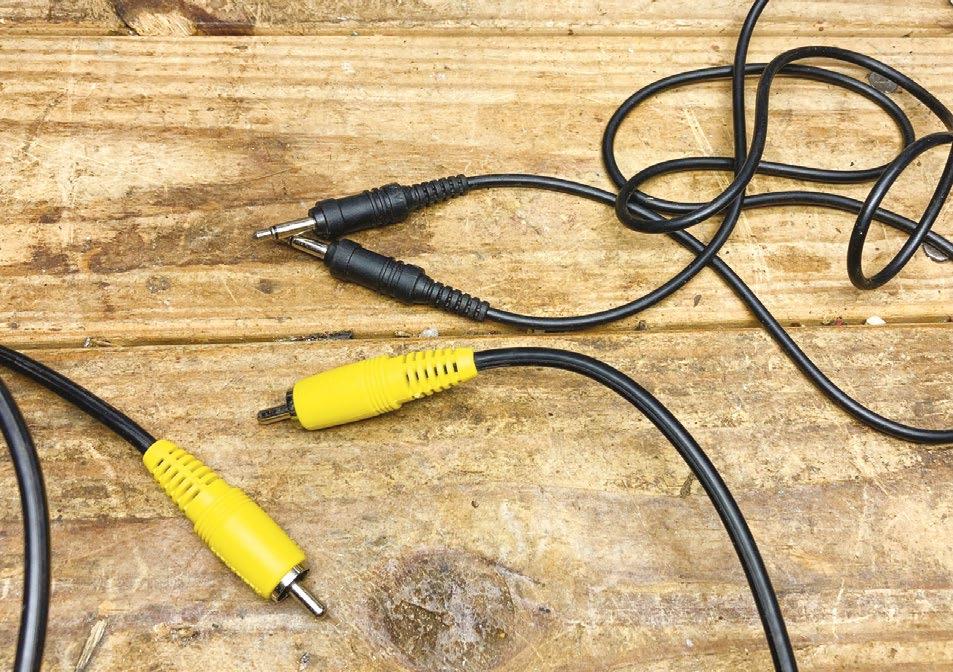

just substitute a male 1/4-inch phono plug where I mention and illustrate a male RCA phono plug.
If your radio already has a phono input, can you just attach your MP3 player to it via a cable? Yes and no.
If you have a male phono or 1/4-inch connector on one end of the cable and a male 3.5 mm (1/8-inch mini) headphone connector on the other, you can physically plug it into the female input on the radio … however, it won’t work. If you get any sound at all, it will be very low because on an impedance mismatch. With a minor bit of surgical doctoring (cutting the cable) and two minor implants (resistors), you will have a cable that connects both instruments and the sound quality will be as good as the radio’s speaker can reproduce, all for almost no money.
Not having a cable with a male-to-male RCA phono on each end and male-to-male 3.5 mm headphone connector on both ends of the other, I decided to create my own from two cables: an RCA-to-RCA and a 3.5 mm headphone-to-3.5 mm headphone. Upon completion, I would have two cables that did exactly what I needed them to do (Figs. 2 and 3).
Writer Chuck Gloman Associate Professor and Chair, TV/Film Department
Fig. 2: A male-tomale RCA phono cable with yellow plastic and a male-tomale 3.5 mm
headphone cable.
Fig. 3: Another view of the two cables I used to create two wires. Note that the tips on the 3.5 mm male connectors are TS (Tip/Shield) for monaural use.
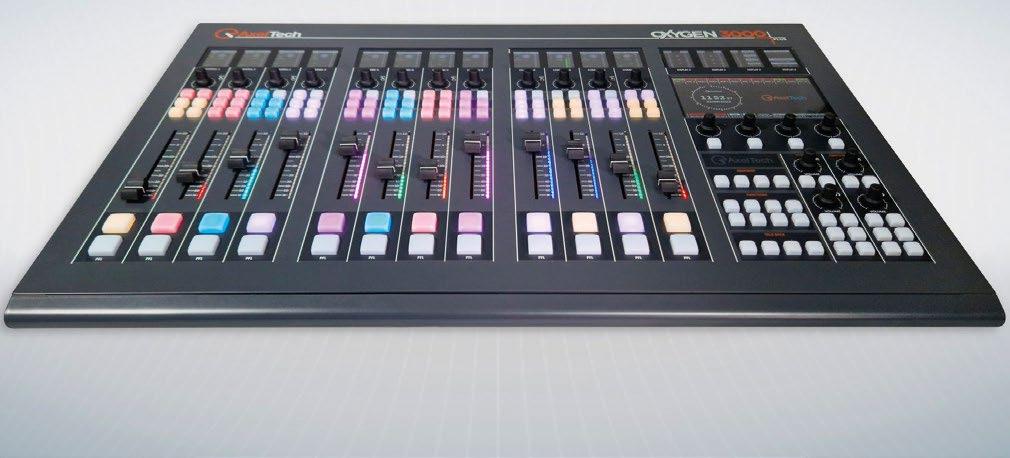




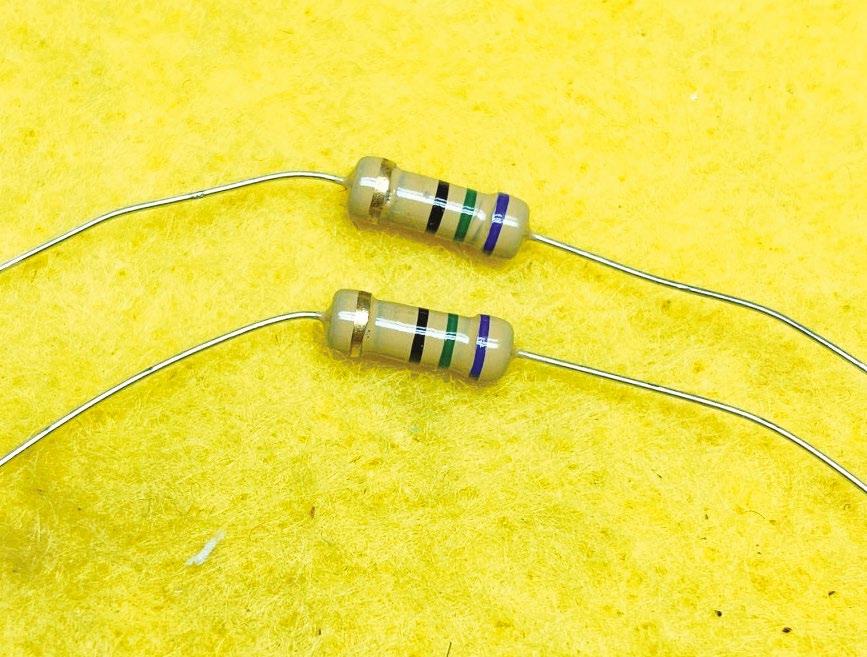
Left
Fig. 4, at top: The cable has been cut. Notice the different size wires. The Blue arrows point to the shielded wire and the red arrow points to the tip wire. Just remember, you need to connect tip to tip and shield to shield.
Fig. 5: The ends of both cables have been stripped. Make sure you have enough wire exposed.
Fig. 6: Two identical 75-ohm, 1/2-watt resistors. It doesn’t matter which end you use; there is not a positive or negative side in a resistor.
Right
Fig. 7, at top: Both resistors with the tubing shrunk over the end. You want to make sure your shield and tip wires don’t touch.
Fig. 8: Both ends of the cable are covered with shrink wrap. No wires are exposed for possible shorting.
Opposite page
Fig. 9: Your cable is now covered and the goiter underneath is hidden.

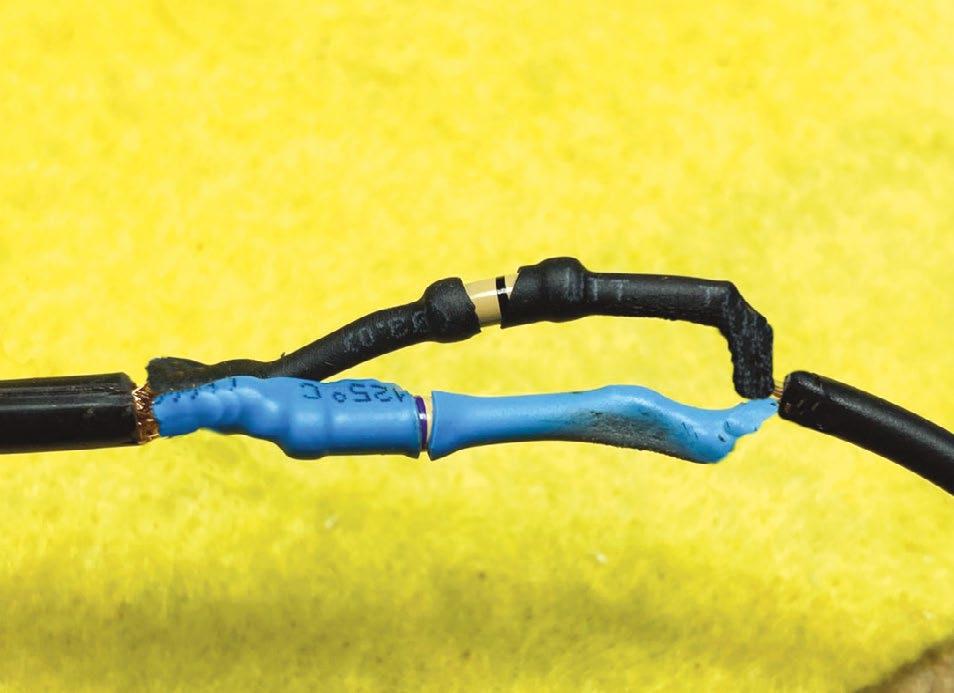
The next step is the hardest: You must cut your cable and strip it to reveal the wires. As I mentioned, I had two cables and I cut each one exactly in half. It doesn’t matter where you cut it; I thought that the middle was easier. Be careful when you strip the wire because the center strands (within the white core) that connects to the tip of the male plug are quite fine. The wires under the black shielding are also quite fine so be careful here too (Fig. 4).
Now that you’ve cut and stripped both wires on both ends, you are ready to connect the resistors (Fig. 5). These resistors restrict the flow of the signal to allow you to hear the sounds from your MP3 player.
The choice of the ohm rating of the resistors isn’t critical. However, the lower the ohm rating, the louder your signal from the MP3 player will be. This means you won’t have to crank the volume too much to hear the signal. I chose two 75-ohm 1/2-watt resistors (Fig. 6).

To keep everything neater, I slid heat shrink tubing over the cable to protect the soldered connections. Take each end of the resistor and wrap the copper wire around it and remove the excess resistor lead. Once both ends are connected (shield to shield and tip wire to tip wire), solder the wires to the resistor leads. Slide the heat shrink tubing over the soldered lead and shrink the tubing (Fig. 7).

Once you have one side soldered, connect the other side, and shrink the tubing in place. It’s not very pretty, but functional (Fig. 8).
Some people might stop here. Although colorful, there’s still too much at stake not to cover the resistors entirely.
Speaking of male 3.5 mm headphone plugs, there are three types of “tips” to be aware of:
TS or Tip Sleeve (aka “mono mini”) plugs have a tip for the audio signal and a sleeve for the ground. There are only two wires to deal with in this type of monaural connection. This is the type I used because my vintage radio doesn’t have a stereo speaker. This set-up needs two resistors.
TRS or Tip, Ring, Sleeve (aka “stereo mini”) is the most common type of 3.5 mm connection. The tip of a TRS plug is for the left-channel signal. The ring is for the right channel. And the sleeve is for the ground wire. This will give you a stereo signal, but you’ll need three resistors because of the extra channel.

TRRS or Tip, Ring, Ring, Sleeve (aka “stereo mini with microphone”) connections are used in headsets or earbuds that include an inline controller and a built-in mic. The tip is for the left channel, and the first ring is for the right channel. The second ring is for the ground, and the sleeve is for a microphone channel. This is not necessary for our conversion purposes and is too expensive.
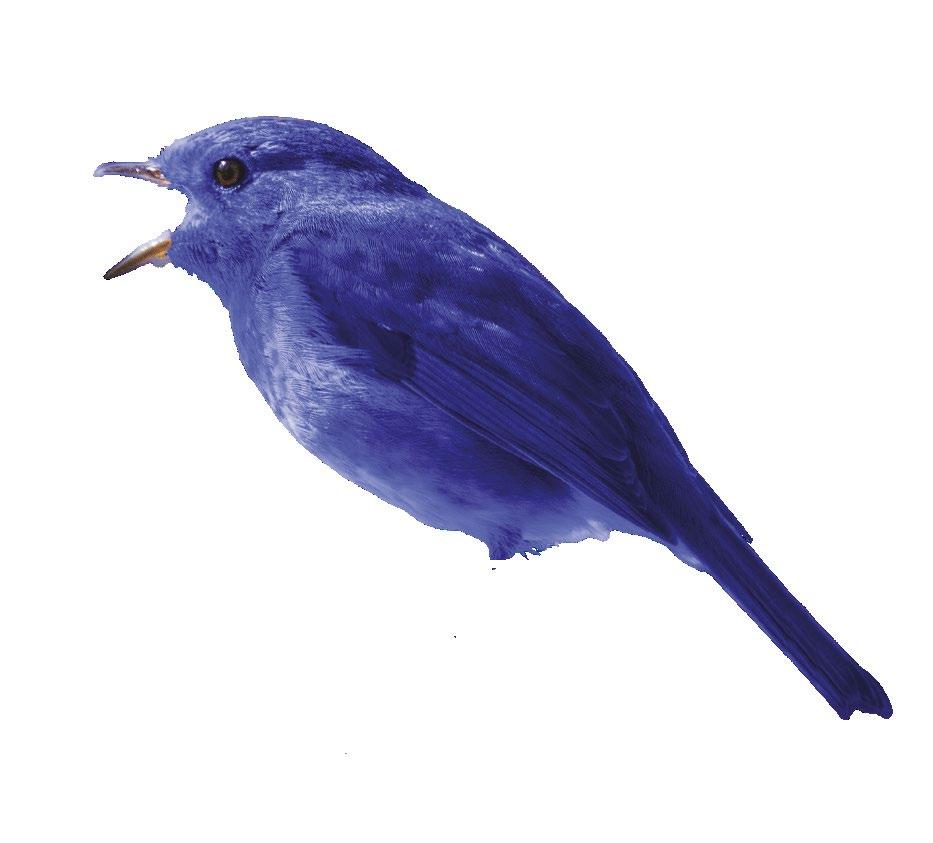

WYSL “Voice of Liberty” is a Class B AM station on 1040 kHz, owned by Radio Livingston LP and headed by Robert Savage. Licensed to Avon, N.Y., immediately south of Rochester, the station also serves the western Finger Lakes area and has two FM translators. It promises listeners that it is “locally owned and fiercely independent in an era of predictable, reactionary corporate radio.”
In the fall of 2022 Savage realized that the 20 kW DA-D four-tower facility that the station had built in 2006 for daytime operation was protecting three stations that no longer existed. “These had been either co-channel or adjacent-channel facilities on 1040 and 1050,” he said.
“Since we had a Nautel AMPFET-25 transmitter with a designed maximum power of just under 30 kW running leisurely at 20 kW, and the WYSL antenna components were capable of higher power, we saw this as an opportunity.”
This story is excerpted from the ebook “Awesome RF Buildouts.” Read about other projects at radioworld.com/ ebooks.
Accordingly, the company engaged in planning with Chief Engineer Mark Humphrey, longtime consultant Bill Sitzman and the RF engineers at Kintronic Labs for an upgrade that would largely use existing facilities.
Sitzman did the allocation work and wrote the application. Humphrey ran a radial from a co-channel station and did the method of moments antenna proof of performance. The Kintronics phasing system was modified and presents a low VSWR common point to the Nautel transmitter. Cris Alexander of Au Contraire Software, who wrote the ACSModel software used for the method of moments analysis, provided assistance on the project.
“This process produced a redesign of the array utilizing a supplemental phase-extension network and cabinet for existing Tower #4, as well as component swaps in ATUs at two other towers,” Savage said. “The pattern-switching equipment and Gorman-Redlich antenna monitor were retained without modification.”
The resulting DA-3 system was filed with the FCC for a CP in January 2023, and the permit was issued in May.






“Kintronic completed the Tower 4 phasor cabinet in a remarkable six weeks, and it was installed at WYSL in late July,” Savage said.
By year’s end the method-of-moments antenna adjustments produced a license application ready for FCC analysis, with the result that a grant was issued in February 2024.
“The new 27 kW coverage has been gratifying, with much better general coverage to the east and west as well as improved signal strength in the two main lobes Remarkably, even with a critical-hours reduction in power from the 2006 level of 13.2 kW to a new level of 10 kW, the redesigned pattern provides better general coverage.”
There was no change in nighttime operation, as WYSL retains its 500-watt DA-N authority and operation from 2006. The station utilizes all four towers on all three patterns.
For daytime and critical hours operation, it runs the Nautel AMPFET-25, and at night it runs a Nautel J-1000 at 500 watts.
“Our standby transmitter is the excellent BE AM 2.5 we purchased in 1996,” he added. “The nostalgic RCA BTA 1-R we signed on with in 1986 for 500-watt NDA operation on 1030 kHz had been donated to the nearby Antique Wireless Association Museum in 2007; it was operable when retired.”
An earlier WYSL was a prominent AM station in western New York state; today that station is WWWS.
This iteration of WYSL began life as a 500-watt daytimer on 1030 kHz in the 1980s. It moved up one channel in 1997, when it began 24-hour broadcasting and it has had several power increases since then. Today it is also heard on two FM translators.











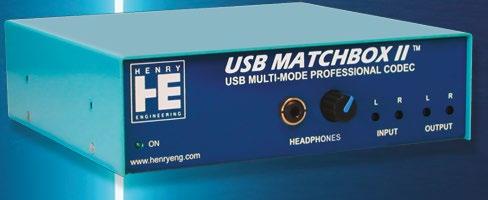

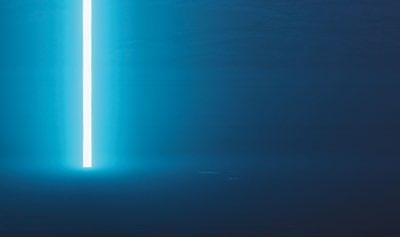



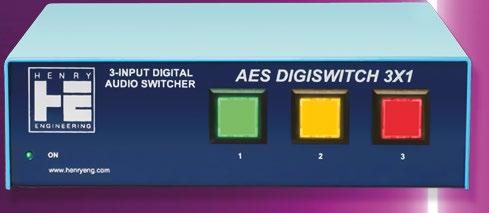

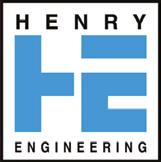


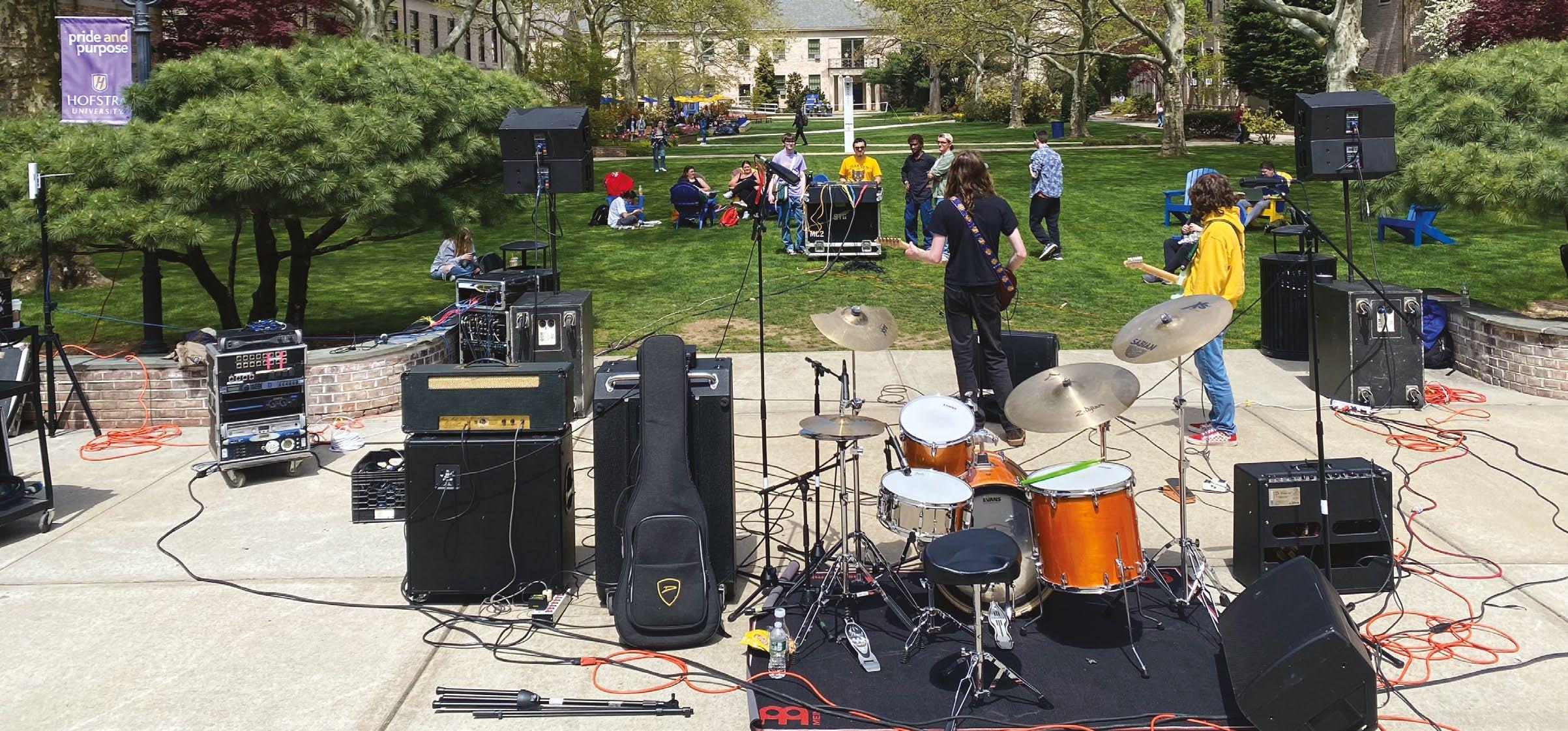
Writer

Jason Eusebio
Senior WRHU audio/radio student, Lawrence Herbert School of Communication, Hofstra University
Audio and radio technology continues to evolve at an astonishing rate, leaving technicians and engineers to adapt to new equipment and attempt to retrofit legacy equipment for modern applications. As audio transitions from physical cable runs to audio over IP, analog equipment moves toward obsolescence.
However, AoIP networks still require physical infrastructure and incorporate analog principles. I realized that as an aspiring broadcast engineer, I would need to develop a better understanding of how AoIP systems are built and deployed.
took to make me want to dive in and start twisting knobs and pushing buttons.
Analog equipment first enticed me into the craft, and its widespread accessibility helped me quickly hone my skills. The lessons I learned from using analog equipment as a young engineer have served me well, and as I now look forward to my professional career, I wanted to be able to offer future students the same opportunity.
Above The equipment was used to create a makeshift AoIP network to broadcast a pop-up outdoor concert on Hofstra University’s campus.
With help and equipment donated by Telos Alliance and the Salem Radio Network, along with the guidance of my academic advisor Dr. Andrew Gladding, chief engineer for WRHU Radio Hofstra University, I decided to design and build an AoIP system using legacy broadcast hardware as a way to expand my knowledge of the subject.
As a high school freshman, I fell in love with audio engineering when I saw my first audio rack. A 10-channel analog mixer, a graphic equalizer and two amps were all it
For this reason, I designed an independent study for my spring semester that would accomplish this goal. The task was to use legacy Telos Axia hardware, specifically generation one analog and microphone nodes, to create a wireless audio over IP network from scratch. While this equipment may be somewhat outdated for many commercial applications, the fundamentals it reflects are still beneficial, and it acts as a great piece of intro hardware for future students. Additionally, I felt that having experience with the Telos Livewire infrastructure would be a major asset for my professional skill set.
Using six IP-configured Telos Axia blades, a QOR frame, Cisco switches and wireless 1-Gig wireless point-to-point system, this equipment laid the blueprint for a makeshift, over-the-air AoIP network that we intended to use for a pop-up outdoor concert on Hofstra University’s campus.
The build process for the network began in late February 2024, and the concert date was in late April, so I had two months to build, design and troubleshoot this system in preparation for a live band multi-mix.
The project required me to arrive an hour before class every week to develop and build the system. Throughout the build process, I encountered several snags, such as the mixing console initially not fitting correctly in the rack mounts and the network having issues handling heavy multicast traffic payloads with stability and reliability. But with some ingenuity, research and trial and error, we overcame the technical obstacles associated with this project.
There were still daunting physical obstacles to overcome. For example, the wireless links for the blades in the stage box and the static rack were tested effectively in a controlled environment during the build process. During the test phase in the shop, the two links were about half a foot apart, while in the practical environment, they would be some 500 feet apart, and the signal would have to circumnavigate a building blocking its path across campus. Additionally, the Cat-6 cable necessary for our wireless transmitter had to be snaked from inside the heart of WRHU’s mainframe through the ceiling conduit and then outdoors through an underground pipe to its position on the WRHU STL mast outside the Lawrence Herbert School of Communication. This work, some of it done in the rain, was painful and exhausting but imperative to the system’s success.
After multiple tests involving carrying the 40-pound stage box across campus and endless hours of troubleshooting collisions between multichannel PCM audio packets, the two ends of the system were locked and seemingly ready for the big test.
On April 24, my focus shifted from the AoIP infrastructure to the live mix infrastructure for the outdoor concert.
Dr. Gladding and other class members got the system in position for its secondary mix transmission while I built the 5,000-watt front of house system on the campus quad. The main static rack of the system would live in a studio inside the Herbert School and feed into a secondary broadcast mix while the stage box received physical inputs from a snake split 500 feet away.
When 1 p.m. came, the concert began and crystal clear audio was received in the studio in real time, down to the two-track output for broadcast over the FM, proving this project a success. The system has shown its efficacy and will serve WRHU and its infrastructure as a learning tool and a means of wireless production.
This project was about using legacy equipment in a modern context and challenging the prevailing thinking in contemporary audio. Nowadays, audio engineering is often seen as a digital practice, whether it’s AoIP or DAWs to create and transport content. However, it’s crucial to

Top Help and equipment were donated by Telos Alliance and the Salem Radio Network.
Above

understand that all these digital practices are built on analog operations, and a solid grasp of digital audio starts with understanding analog principles and basic signal flow.
On a personal level, this project marks my first foray into creating the infrastructure of an AoIP network, a skill that will undoubtedly serve me in the future when dealing with MADI or DANTE-configured spaces. This was a successful exercise in repurposing yesterday’s technology for tomorrow. The results were a personally fulfilling learning experience. This journey of personal and academic growth would not have been possible without the invaluable collaboration between Dr. Gladding, Telos Alliance and Salem Radio Network.
